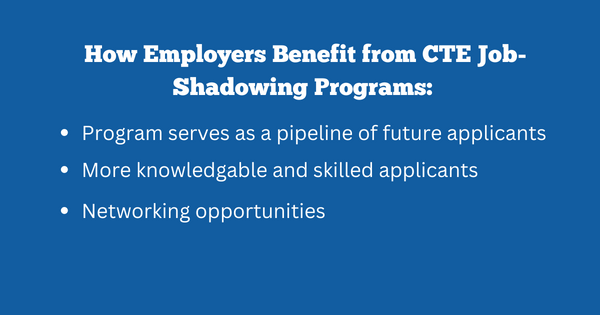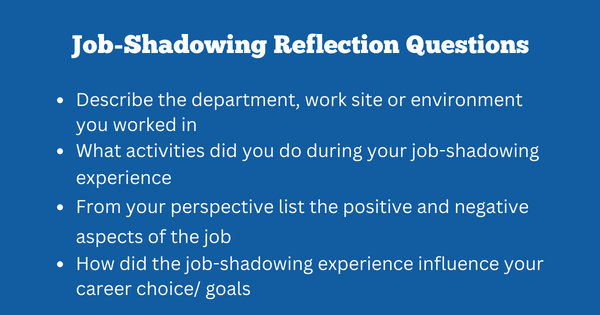Career and Technical Education (CTE) | Work-Based Learning | Teacher & Classroom Resources | Administrators
A Road Map to Implementing Work-Based Learning in Your CTE Program
Josh Witherspoon, a CTE marketing specialist, is a former Texas FFA state officer and Texas Tech graduate in agricultural communications. He leverages his expertise in content development, marketing, and CTE to showcase the successes of CTE educators and students and the value of iCEV.
Unlike any other form of education, career and technical education (CTE) has the ability to expose students to a wide range of career opportunities and technical skills to prepare them for future workplace success. As CTE aims to bridge the gap between the classroom and the workforce, work-based learning (WBL) offers immense value to today’s students through hands-on learning experiences that bring students expert insight and exploration of industries and career opportunities.
But what exactly is work-based learning? And what are steps you can take to implement it into your CTE program.
Below, we'll briefly review the definition of work-based learning. Then, you'll learn five key steps to implementing work-based learning in a CTE program:
- Network
- Share the Value of WBL
- Set Goals and Parameters
- Help Students Reflect
- Measure WBL Performance
When you've finished reading, you'll have a better idea of how to implement work-based learning in your CTE program. More importantly, you'll learn how you can measure results and use them to enhance opportunities for students.
What Is Work-Based Learning?
Work-based learning (WBL) is an educational strategy that provides students with real-life work experiences where they can apply academic and technical skills and develop their employability.
WBL encompasses both out-of-classroom apprenticeship, pre-apprenticeship, and intership programs as well as work-based experiences (WBE) like classroom speakers and factory tours.
Collectively, these opportunities allow students to experience first-hand what it’s like to work in a specific career field.
Below, we'll consider five steps CTE programs can take to build successful WBL and WBE experiences for their students.
1. Network
For educators looking to implement work-based learning into their CTE program, establishing a job-shadowing program offers value to student’s educational careers and to the future of local business and industry.
The first step in successfully implementing a job-shadowing program is to network with local businesses and organizations who might be interested in participating in work-based learning partnerships or hosting standalone work-based experiences.
Before administrators and teachers begin networking, it’s important to work on perfecting your elevator pitch by being able to explain what work-based learning is and how it benefits students and employers. Have conversations with your neighbors, friends, family members, and parents at school to gain insight on successful local businesses to pair with students.
The key to successful networking for a job-shadowing program is consistent messaging and regular efforts to intentionally engage with your local workforce. Stay connected to local businesses and industries and share benefits associated with engaging in a job-shadowing program including:

When you network well, you lay the foundations for strong community partnerships that promote work-based learning and lead to valuable professional opportunities for future CTE graduates.
2. Share the Value of WBL
After recruiting employers to the program, the next step should be hosting an orientations and introductory meetings.
Make sure to tailor your message to suit the audience. If you have students, families, educators, and employers all attending the same meeting, then you want to offer a very general overview of the program.
It’s important to remember that employer partners are experts in their field, but they might not have any experience working with students. So just as you would explain workplace professionalism to students, it will be equally helpful to provide guidelines for mentoring and working with students to the onsite supervisors.
Ultimately, you want to communicate clearly what you hope to accomplish through work-based learning to all stakeholders. Doing so will ensure a full investment from the beginning, increasing your chances for program success.
3. Set Goals and Parameters
The most important facet of implementing a successful job-shadowing program is the processes CTE administrators teachers set in place before students start working with industry professionals.
Before pairing learners with professionals, educators should set appropriate parameters including start and end dates, where students will be working, and when students will job-shadow over the duration of the WBL experience. Defining this information provides clear standards and procedures for students and professionals to abide by keeping everyone involved on the same page. Often, these parameters may be required by law, so it's best to track them with a secure data management solution.
Educators might also set goals with industry partners by discussing what types of skills or subjects they need to learn while shadowing in a professional workplace. This information can also be tracked and stored in a CTE-specific data data management solution.
At a minimum, CTE educators should be aware of the skills students develop during their work-based learning experiences so they may continue to teach these concepts in the classroom and further strengthen students understanding of how their education supports their future career.
4. Help Students Reflect
After students have successfully completed a work-based learning program or individual work-based experience, it’s important for students to reflect on what they learned in order to get the most out of the opportunity.
Reflective practices help learners find relevancy and meaning in their experiences and reinforce connections between educational settings and real-life situations. To help students reflect, ask questions about their experience that prompt them to think intentionally about what they've gained from work-based learning.
Reflective activities can be presented to students in a multitude of ways. It's important for educators to ensure students are continually challenged to consider what they've learned and analyze how they could apply their skills in the future.
Ideas for reflective questions to prompt students with after completing their job-shadowing experience include:

Ultimately, reflection exercises help your students close the circle on their work-based learning experiences, reinforce learning, and prepare them for industry success after completing your CTE program.
5. Measure WBL Performance
Work-based learning experiences take CTE to the next level through helping students connect class concepts to the skills required for workplace success. Through full WBL programs and individual work-based experiences, students have the opportunity to explore unique industries and career opportunities that give them valuable experience to make more informed decisions and better understand the importance of their education.
However, to ensure that your work-based learning efforts are meeting the needs of all of your CTE students, you need to measure participation in work-based learning and the overall performance of your WBL initiatives.
Tracking work-based learning allows you to keep a record of all of your partnerships and opportunities. When you track both traditional WBL programs such as internships, pre-apprenticeships, and apprenticeships, you're able to demonstrate how students have learned particular skills that lead to real-world employment. When you also keep record of WBE activities, you'll see the connections these individual experiences make to student success in the classroom.
Measuring performance regularly and accurately with a data management solution can help you prove the value of your CTE program, helping you maximize your funding opportunities to benefit teachers and students.
Track Work-Based Learning Using Eduthings
In this article, you've discovered steps you can take to implement thriving work-based learning initiatives in your CTE program. When you build networks with your community, share the value of WBL, set appropriate goals, and help students reflect, you'll create a successful WBL road map you can rely on year after year.
But ultimately, the best way you can optimize your work-based learning efforts is to measure the performance of your program and use data to enhance opportunities for teachers and learners.
To ensure that all of their work-based learning data is tracked effectively, many CTE programs have turned to Eduthings. Eduthings is comprehensive data management solution that records both traditional WBL partnerships and work-based experiences like guest speakers and factory tours.
Want to learn more? Read about how Eduthings tracks WBL to discover if it's right for your program:


